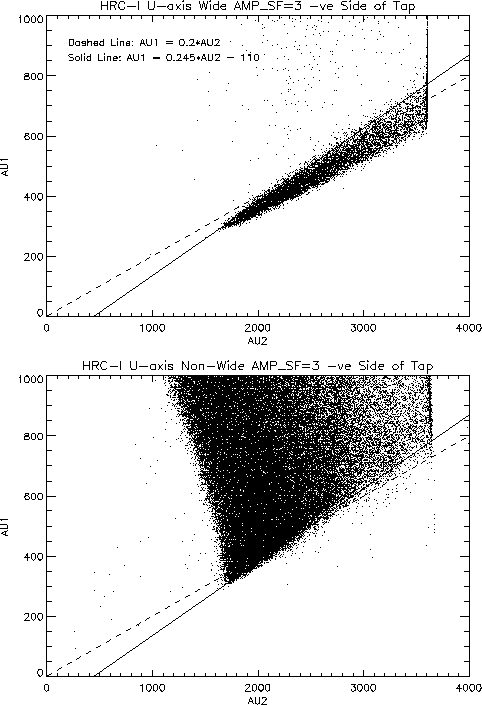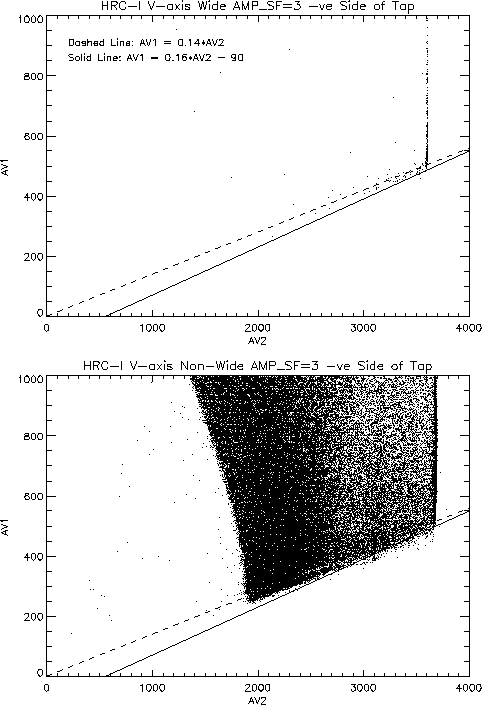Identifying Events with Ringing Tap Signals
Introduction
In an earlier memo,
"HRC tap corrections", and
more detailed SPIE
paper I described a method to remove some of the distortion
in calculated HRC event positions by applying corrections to the
crossed-grid charge detector signals. The method involved
identifying which events were affected on each axis on an
event-by-event basis and for these events adjusting one of the tap
amplitudes according to the other two tap values on the axis using
an empirically derived relationship.
A major issue in performing the correction is identifying the events
to which the correction should be applied given the available
telemetry. From our understanding of the fundamental problem with
the HRC hardware, we know that the events that are affected by the
ringing problem occur when an even number of taps have signals
above a threshold level and the event amplitude is large enough
for the hardware to select the lowest gain setting on the range
switching amplifiers. The amplifier scale selected by the hardware
for event processing appears in telemetry for each event (it is,
however, occasionally
reported
incorrectly). Unfortunately, we have no direct measure of
the number of taps along an axis that have a signal above
threshold. The earlier memo
suggested using a simple ratio comparison between the two tap
signals; however, the data to support this criterion was limited.
In the SPIE paper, I
suggested that we could obtain a nearly unambiguous indicator of
which events required the correction by lowering the event-width
threshold from 3 to 2. The event-width is determined by the HRC
coarse position logic from the highest and lowest number taps
above the trigger threshold. If the width of the event along a
detector axis in coarse position units exceeds the commanded
event-width threshold a bit in the event telemetry is set. At a
threshold value of 3, very few (~0.1%) events have the width
exceeded bits set, indicating that nearly all events have a width
of 3 or less. More critically, those events with a width on an
axis of more than 3 appear to be attributed to non-X-ray events
and have other signatures that can be used to reject them.
Effective 2000:279:12:57 the commanded default event-width threshold
was lowered to 2. This provides us with an improved means to
identify the events which require a tap signal correction. It also
provides us with the data we need to improve our means of
determining which events should be corrected when for the times
prior to the lowering of the event-width threshold.
Which Event to Correct?
The events processed on the lowest gain setting (AMP_SF=3) and which
have an even number of tap exceeding a threshold are subject to
the ringing problem. Since very few events have a width greater
than 3 coarse positions, once the commanded event-width threshold
is set to 2 we can assume that if the width exceeded bit is set,
the width is 3. The total amplitude of the events when the
hardware selects the lowest gain setting is such that the event
width is always greater than 1. Thus when AMP_SF=3 the state of
the width-exceeded bit for a given axis tells us whether we
should apply a ringing correction (if not set apply one, if set do
not apply one). We can use this indicator in an examination of tap
data to define better criteria for applying the correction when
the commanded event-width threshold is set to something other than
2. Figure 1 shows scatter plots of events from an HRC-I data set
where we have used the width-exceeded bits to distinguish events
that do not require a ringing correction (Wide Events) from those
that do (Non-Wide Events). The events were selected to have
AMP_SF=3, be on the negative side of the coarse position, and be
well behaved in some other simple respects (center tap of the
triplet is largest, sum of tap signals on U or V is non zero,...).
 |
 |
| Figure 1: a)
Comparison of AU1 to AU2 on HRC-I for Wide and for Non-Wide
events. Non-Wide events should have a tap ringing correction
applied before event positions are calculated. The dashed
line is the current discrimination criterion; the solid line
is a suggested improvement. |
b) Comparison of AV1 to AV2 on HRC-I for Wide and for Non-Wide
events. Non-Wide events should have a tap ringing correction
applied before event positions are calculated. The dashed
line is the current discrimination criterion; the solid line
is one suggested improvement. |
The first thing to notice is that a much larger fraction of the events
on the U-axis are wide than on the V-axis. The wide an
non-wide events segregate, as is expected, but the boundary is
fuzzy. There are two lines over-plotted in the plots in the
figure. The dashed line in each pane is the currently defined
discriminator of when the tap ringing correction is to be
applied; clearly this is a poor choice. The solid line is an
improved criterion for discrimination; however, on the HRC-I
V-axis we might just as well apply the correction to any event
on the negative side of the coarse position when
AMP_SF=3. Figure 2 Is a similar plot to figure 1 but for the
HRC-S. As with the HRC-I V-axis, the ringing correction could
be simply applied to any event on the negative side of the
coarse position when AMP_SF=3.
 |
 |
| Figure 2: a)
Comparison of AU1 to AU2 on HRC-S for Wide and for Non-Wide
events. Non-Wide events should have a tap ringing correction
applied before event positions are calculated. The dashed
line is the current discrimination criterion; the solid line
is a suggested improvement. |
b) Comparison of AV1 to AV2 on HRC-S for Wide and for Non-Wide
events. Non-Wide events should have a tap ringing correction
applied before event positions are calculated. The dashed
line is the current discrimination criterion; the solid line
is one suggested improvement. |
Suggested Updates to "hrc_process_events"
A few changes are required in the CIAO tool "hrc_process_events" to
make use of this improved identification scheme.
- Add a "switch" to select which of the identification methods to
use. This switch should be set by the value of the telemetry
mnemonic: 2WDTHAST
- If 2WDTHAST = 2, use the width-exceeded bits to determine which
events should be corrected.
- Modify the current A1 versus A2 discrimination test from a ratio
to a line.
- Add a column to the ringing correction coefficients file
(TRING_OFFSET) and update the coefficients (table of
suggested coefficients is below).
- If A1 > TRING_THRESH12×A2 + TRING_OFFSET, apply the correction
- Add code to use the width-exceeded bits in the event status
rather than the A1 versus A2 relationship.
- If axis width exceeded bit is 0, apply the correction
Suggested Coefficient Updates
| HRC-I | HRC-S |
| U | V | U | V |
| TRING_THRESH12 | 0.245 | 0.0 | 0.0 | 0.0 |
| TRING_OFFSET | -110 | 0.0 | 0.0 | 0.0 |
Mike Juda
Last modified: Mon Mar 26 10:11:20 EST 2001





